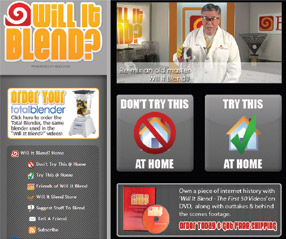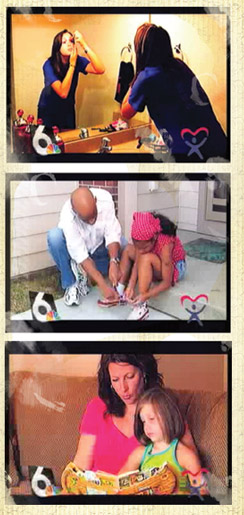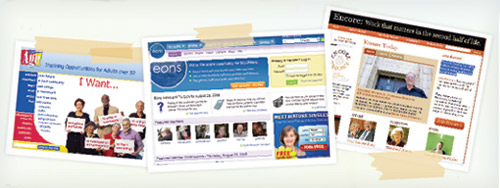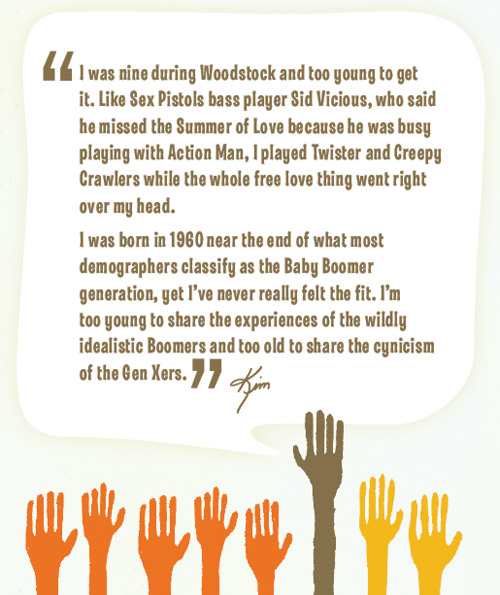February 18th, 2009
The Cat & Mouse Game of SEO
Many companies think of search engine optimization (SEO) as the Holy Grail of online marketing. While SEO can be an effective and cost efficient marketing tool, it’s important to understand two things:
- It’s not a one-time task – it’s an ongoing, time-consuming commitment.
- It comes without a guaranteed return.
Why? Let’s start with the fact that optimization is a moving target. Today’s best practices are outdated tomorrow. And the methods search engines use to rank results are constantly changing. It’s also a never-ending game of cat and mouse. As your competition adjusts their tactics to meet or beat yours, you have to be prepared to refine and change your approach.
Nonetheless, your company can see tremendous benefits if done properly. To get started, optimization tactics should be broken down into two equally important, yet very distinct, pieces:
ON PAGE
This is the code and content on your website. Since you have full control of this piece, it’s the best place to start.
My friend from Dominate With SEO once gave me advice that’s been useful ever since – study the way each of the key search engines (Google, Yahoo and MSN/Live) rank results. There are a number of things each indexing algorithm looks for when evaluating your code. Things like unique page titles for each page, the way link text is coded, the use of heading tags to denote important terms, and image alt tags that describe an image are all fairly easy to use and can help your results.
Your Web copy is vitally important to your success in optimizing. Search engine friendly copy is important, but write for your human viewers first and foremost. Don’t let the quality of your message get lost in repetitive language developed for iFlex Studios SEO purposes.
LEARN ABOUT HOW THEY WORK
Google google.com/support/webmasters
Yahoo help.yahoo.com/l/us/yahoo/search/webpublishers
MSN/Live webmaster.live.com
Evaluate your industry and pre-plan the most important terms to implement into your copy. You may find important key phrases you hadn’t thought of. The Google Insights for Search tool is a great place to start.
It’s also vital to update your site regularly with new, meaningful content. The more pages that hold unique content, the more potential visibility and entry points you have.
OFF PAGE
Search results have changed. It’s no longer just pages from websites that appear in the results. For example, Google is continually merging its stand-alone Web, image, video and news searches into one universal results page. What this means for companies is that your corporate website content is no longer the only result from a search of your company’s name. The upside is that you can begin creating and publishing your own new content across a variety of platforms such as YouTube, blogs and news services and see those efforts pay off in your search rankings.
Search engines give significant value to links from other sites. The more links to your site from credible sources, the higher your potential page rank. It makes sense, because it means your content has value to users.
SEARCH ENGINE INDEXING LIMITS*
Page File Size: No more than 150 kilobytes (Before Images, CSS and other Attachments)
Amount of links: No more than 100 unique links per page
Title Tag: No more than 70 characters
Meta Description: No more than 155 characters
Parameters in URL: No more than 2
Depth of URL : No more than 4
*Does not apply to websites with significant authority
Links with partner companies, customers and vendors is a good place to start but don’t stop there. Join the current online conversation in your industry. Post comments on blogs in your category. Add a blog to your own site. It’s a great way to not only get more exposure, but to become a leading voice in your sector.
Search engines have given any company, large or small, the opportunity to market themselves to the entire world. Now is the time to move and take your place in this powerful marketing space.
February 18th, 2009
Making the Most of a Recession
 To cut or not to cut, that’s the marketing question. During this recession many clients are evaluating every expense. Many may not realize that cutting your marketing budgets can have significant consequences, both now and in the long run.
To cut or not to cut, that’s the marketing question. During this recession many clients are evaluating every expense. Many may not realize that cutting your marketing budgets can have significant consequences, both now and in the long run.
According to a study from McGraw-Hill Research, companies who consistently marketed themselves during the recession of 1981 & 1982 had sales 256% higher after the recovery than those who stopped marketing.
Recessions can be an opportunity for companies to differentiate themselves. There are countless ways to keep your company’s brand in the forefront of consumers’ minds. For example, Bozell’s Smartargeting combines intelligence, strategy and targeting to keep your brand in front of the customers you want most.
Your first priority during a recession should be customer retention. By using some creative analytical tools and messaging that compliments your strategy, you can develop a footprint of your best client, then find prospects that look just like them.
Our advice is: make a plan; plan your work; work your plan.
 By following these simple rules, you can maximize your marketing budget. Defining lifestyle tendencies and household demographics are the keys to smart spending. These tactics are not only return-on-investment-driven, but also relationship-driven.
By following these simple rules, you can maximize your marketing budget. Defining lifestyle tendencies and household demographics are the keys to smart spending. These tactics are not only return-on-investment-driven, but also relationship-driven.
Companies in tough industries, such as building manufacturers, have continued to promote their brands by using integrated techniques. Using database marketing can be as effective as advertising because it is targeted to resonate only with your selected audience. By segmenting your target audience into opportunities, you can develop the most cost efficient way to communicate to them.
This strategy is not only successful with businesses that market directly to consumers, but also with organizations which target other businesses. Business to business companies often use Smartargeting to find those that will pass credit hurdles and continue to bring in money. Pre-screening based on acceptable selection criteria such as credit and years-in-the-business will help your company maintain its ROI.
The current recession offers a chance for companies to differentiate their business and better position themselves for the future. Smartargeting allows our clients to wisely spend their marketing dollars and better learn how to serve their customers.
February 18th, 2009
The Future of Television Advertising
 Everyone is worried about the future of television advertising. Lower ratings, spiking costs and over-fragmentation are causing some advertisers to search for more integrated mediums. DVR and the ability to completely bypass commercials aren’t helping. More alternatives mean budgets get spread even thinner, often leaving a smaller percentage for the television piece of the advertising pie. So what is the television industry doing to stem the tide? More than you might realize.
Everyone is worried about the future of television advertising. Lower ratings, spiking costs and over-fragmentation are causing some advertisers to search for more integrated mediums. DVR and the ability to completely bypass commercials aren’t helping. More alternatives mean budgets get spread even thinner, often leaving a smaller percentage for the television piece of the advertising pie. So what is the television industry doing to stem the tide? More than you might realize.
Historically, the primary benefit of TV has been its mass reach. But in a world of personalization and individualization — in a world where audiences no longer plan their week around rigid programming — this business model starts to falter. How can you continue to be relevant to an audience in perpetual motion? To answer this question, TV is becoming more things to more people and, in the process, reinventing itself. Below are a few examples:
Interactive Television
TV as Point of Purchase:
Cable networks are integrating point-of-purchase capabilities directly into programming. With a simple click of the remote, viewers are able to make a purchase or receive product details via Video-on-Demand. The cable companies have enough consumer data housed to micro-target based on behavioral and geographic variables. This technology is estimated to be mainstream by 2010.
Apple TV:
One of the first successful attempts to integrate online with TV, this service offers the ability to rent HD movies, buy HDTV shows, buy iTunes music, share photos and even download YouTube videos. Where consumers once needed three or four separate devices to access similar content, now there’s one. Not only will you have access to everything through one screen, but highly targeted, personalized messaging will allow advertisers to eliminate wasted messaging on a non-target audience. While this will take time to develop across the TV industry, experts argue it will be the model for the industry moving forward.
Interactive Television Partnerships
Mobile:
The TV industry has branched out into the mobile platform. SinglePoint (an interactive TV firm) formed a partnership with multiple networks like Fox, NBC, MTV, Bravo and the CW to deliver ads when someone engages in a call-to-action via their mobile phone. For example, when someone votes on American Idol, they automatically receive a targeted ad based on demographics from the wireless provider. Due to the extensive demographic knowledge carriers have of their customer base, it allows advertisers to specifically target their messaging.
Interactive Integration:
NBC’s recent Olympics coverage was a new case study for the industry to emulate. With content occurring around the clock, the network continually updated results and included up-to-the minute video of events that weren’t streamed on their main site. We talk about media fragmentation and the need to reach multiple touch points, this campaign did an excellent job. It included 2,200 hours of live online coverage, blogging by commentators, live events via mobile phones, Video-on-Demand and even a way to download coverage to a computer.
We live in a society where fragmentation is forcing media outlets to re-examine, and in many cases re-invent themselves almost overnight. It’s exciting for the consumer, but it’s even more exciting for advertisers. As you can see from the examples above, we have more resources and more capabilities which all translates into more efficacy. Advertisers will benefit by eliminating messaging to unnecessary audiences, and focusing their spending where they’ll get the highest return.
February 18th, 2009
Social Media: A Virtual Cocktail Party
We all know the feeling. You walk into a cocktail party, scan the room and everyone is a stranger. You tell yourself that your clients, colleagues or whomever you’re there to see, will arrive eventually. Yet, how do you avoid looking like a wallflower or feeling out of place until they do?
 The first order of business in an unfamiliar situation is to observe the room, listen for conversations of interest and find an appropriate opportunity to enter the conversation. With a little time and tact, your party will arrive and you just may meet someone interesting in the interim. These same cocktail party rules apply to conversations in the online world.
The first order of business in an unfamiliar situation is to observe the room, listen for conversations of interest and find an appropriate opportunity to enter the conversation. With a little time and tact, your party will arrive and you just may meet someone interesting in the interim. These same cocktail party rules apply to conversations in the online world.
Many companies and organizations know that they need to be in the social media space, but aren’t sure of how and when to participate. They know that social media is becoming an important part of the marketing mix, but the potential risks and requisite transparency often seem daunting. However, just like a cocktail party, patience and persistence are paramount to making important connections in the online world.
Observing and tracking the conversation is a vital first step in developing an effective social media program. By first listening to the conversation, you will find what’s being said, who is saying it and who is listening. Like traditional marketing communications campaigns, you’ll be able to craft unique messages, target specific outlets and enter the conversation in an unobtrusive way. But just like you wouldn’t scream your name over a bullhorn at a cocktail party, you shouldn’t blast your sales message to the entire online world.
Evangelists and influencers are looking for value, information and a reason to listen to you. They want to interact with organizations and people that are knowledgeable and genuine. Participating in any conversation — both traditional and online — is about appropriate dialogue, interaction and exchange of information. Listening and observing first will give you the best chances of success.
So don’t forget the cocktail party rules when developing your social media strategy. You never know who you might meet.

February 18th, 2009
Are You Jonesin’?
Somewhere between Woodstock and Lollapalooza lurks an enormous, largely overlooked generation. Meet Generation Jones.
First publicized in 2000 by sociologist Jonathan Pontell in his book, Generation Jones, this segment has received a great deal of media attention lately. And with the election of President Barack Obama, born in 1961 and clearly a Joneser, this generation is getting even more attention.
Our coming-of-age decade, the 70s, is the butt of jokes and remembered by most for its kitsch (polyester, shag, disco, etc.). Yet while battles for change (sexual revolution, women’s movement) were fought in the ‘60s, the actual broad societal shifts didn’t occur until the ‘70s – albeit with much less fanfare. We grew up in that shifting time. A time that created a unique balance in our thinking between idealism and cynicism, which is considered a hallmark Generation Jones trait.
“Jonesers,” those born between 1954 and 1965, were sandwiched between the Baby Boomers and Generation X. America was exhausted by the intensity of the ‘60s and burned out from the impact of the Boomers. Collectively, we just weren’t ready for the idea of another generation. Even if there are 53 million of us.
While Civil Rights protests, the Vietnam War and the emergence of the sex/drugs/rock & roll were taking place, we were children oblivious to the meaning of it all. Yet our young hearts were politically stoked watching the collective bonding and generational activism of the Boomers ahead of us. We spent our childhoods watching the ‘60s churn with a sense of both horror and hope. Many of us looked forward to our turn in the ‘70s, an opportunity that never arrived. Instead, we lost our innocence, as the nation did, as we searched for an identity in the Me Decade.
If you can sing the theme song to Scooby Doo — Where are You? (‘69-‘72) and Josie and The Pussycats (‘70-‘76)…if you can name all the Bradys (‘69-‘74)1 and the members of the Partridge Family (‘70-‘74)2…or if you automatically crank up the volume when Stairway To Heaven (Led Zeppelin, ‘72), Free Bird (Lynyrd Skynyrd, ‘74), Dream On (Aerosmith, ‘76) or Hotel California (Eagles, ‘77) you too may be a Joneser.
Originally, “jones” was a little-known slang word. It was our generation that spread its use and transformed its meaning. To “jones” means to strongly crave something or someone. Many believe the concept of “jonesin’” is among our generation’s key collective personality traits.
Although Jonesers have grown into a practical bunch, Mr. Pontell says we long for the love and the better world once promised. Which just might be one reason why President Obama’s platform of change resonated so well. That and, despite our low profile, members of Generation Jones tend to be less partisan and wider swing voters than other generations.
1. Marcia, Gregg, Jan, Peter, Cindy, Bobby
2. Keith, Laurie, Danny, Christopher, Tracy
November 23rd, 2008
Reputation Management
Consumers and their opinions can make or break your brand. This has always been the case. Historically, companies have had to depend on focus groups, surveys or annual consumer preference studies to understand people’s opinions of their brand and products. Now, the world moves faster. Brand equity can be destroyed overnight. The Internet has dramatically changed the way people interact and discuss brands.
Beyond giving every consumer a near-instant voice, the Internet has also provided companies many free tools to monitor, manage and interact with consumers. The knowledge gained from using these tools can dramatically improve your company’s awareness of coming trends and crowning concerns. It can also allow for you to quickly respond to problems.
Here are some free tools that you can start using today to help manage your company’s reputation in the digital space:
Google Alerts is one of the most common tools available. This service allows you to select the search terms you would like tracked, as well as the type of content, such as news, blogs, Web, video and groups. You then select how often you wish to receive alerts and the email address you want them sent to. Then, whenever news on your selected search terms becomes available it is delivered to your email inbox.
Twitter is a rapidly growing social networking site. Unlike bloggers, Twitterers post quick entries in their feeds. Users can then choose to follow other Twitterers and comment on their postings. What makes Twitter different is the instant response of a Twitter post. You can get up-to-date information regarding conversations on this service by using the Twitter search tool located at search.twitter.com.
Technorati is a search engine specific to blogs. You can use the standard Technorati search to find blog posts about specific keywords or you can use the “watchlist” service. With a free account, you can enter any number of key phrases in the system and see real-time listings of blog posts that contain key phrases. You can also subscribe to these lists as RSS feeds and pull them into your preferred feed reader.
Search Engines are perhaps the most obvious option. Google, Yahoo and Live make up the vast majority of Web searches performed on the Internet, so they should be the focus of your efforts. In all three of these search engines, you can search for a variety of content types such as Web, images and video. Google allows you to search blogs as well.
Social Networks such as Facebook, MySpace and Friendster house millions of user profiles. Most of these users list their preferences and interests on their profiles. Services like Wink.com allow you to search across many of the social networks. This search can help you to establish which users enjoy your product and list it as an interest. These users have the potential to become brand ambassadors, spreading the goodwill of your company and product.
While all of these tools can get you and your company started, there is a great deal more information that can be attained and managed from the Internet. With the right marketing partner, these tools, along with a variety of sophisticated solutions, can create reports on current trends, help develop a strong marketing plan and help to engage and encourage your existing fan base online.
November 23rd, 2008
Employee Engagement
Best Practices in Marketing Techniques
“ENGAGED EMPLOYEES DO THEIR JOBS BETTER” is hardly an earth-shattering concept. It is common sense that someone with the talent and experience to perform their role, who understands their contribution to the company and who works in an environment that allows for an emotional attachment to their company and coworkers performs better than someone who is ill-suited to their job, disconnected from their company’s products or services and/or forced to report to a poor manager.
While the concept of employee engagement is common sense, the challenge for business leaders is to decode and impact the factors that influence employee engagement in their organizations.
From the human resource arena are two tools that many organizations use in their efforts to drive employee engagement — hiring instruments and employee surveys.
Understanding that one of the easiest ways to create an engaged workforce is to hire employees with the propensity to fit within a company’s culture, psychometric screeners compare applicants with a company’s most successful employees (and by extension, it is believed those in the organization that are most engaged). These tools can be useful, as long as correlations to the subsequent performance of those hired are verified often.
Employee surveys are used in an attempt to quantify a company’s employee engagement, compare this score with a standard and give management feedback about employee opinions. This data can be used as a basis for management development and manager-employee communications.
 Employers have also begun to borrow from marketers to better connect with their employees. Using some of the same indicators and messaging processes as those used in customer branding, companies are creating equally strong employee brands to drive advocacy. Successful employee brands define employment attributes and employee acquisition/retention drivers and use messaging to communicate to prospective and current employees. Also comparable to customer branding, employee brand managers use techniques beyond traditional employee surveys to measure the “employee experience,” gaps between expected and actual experiences and variances between locations, workgroups, tenure and function.
Employers have also begun to borrow from marketers to better connect with their employees. Using some of the same indicators and messaging processes as those used in customer branding, companies are creating equally strong employee brands to drive advocacy. Successful employee brands define employment attributes and employee acquisition/retention drivers and use messaging to communicate to prospective and current employees. Also comparable to customer branding, employee brand managers use techniques beyond traditional employee surveys to measure the “employee experience,” gaps between expected and actual experiences and variances between locations, workgroups, tenure and function.
On the short-term horizon are more parallels with marketing. Macro study of employees, most often by an age demographic (i.e., Boomers, Gen Xers, Millennials), is moving to individual businesses, as employers segment employees to adjust messaging, workplace environment, management techniques and team assignments. Similar to external marketing, employers will almost certainly begin to use lifestyle and psychographic data to further micro-target both current and potential employees. Also mirroring the external marketing trend of moving from one-way monologue messaging to two-way dialogue, expect to see changes in how companies and employees communicate. Beyond automating the “employee suggestion box,” many employers already are beginning to use social networking strategies and mechanisms to build employee relationships.
In the future, expect to see even more use of marketing techniques relative to employee engagement, as the evolution of communications and data collection continues to change both the marketplace and workplace. Businesses, especially those with multiple customer service touchpoints, will do well to keep a close eye on ways to impact employee engagement and performance.
UP NEXT
In the September 8th, 2008 edition of BusinessWeek, author Stephen Baker, in an excerpt from his recently released book Numerati, discusses a future scenario well beyond the segmentation of employees by demographic or lifestyle. Mathematicians at IBM are currently harvesting massive amounts of data on 50,000 of the company’s technical staff to build predictive models around employee assignments and measurements of performance. Personnel files are off-limits for privacy reasons, but almost every other piece of data is fair game. The researchers are combing through backgrounds and project records to garner skills and experience, online calendars for how employees use their time, cell phone and handheld computer usage to track movements and call records and email behaviors to ascertain both formal and informal social networks. Their ultimate goal — to automate what we now call management.
November 23rd, 2008
Integrating Online Video Into the Marketing Mix
You are now free to watch whatever you want, whenever you want, wherever you want.
In addition to DVR timeshifting, we can now easily placeshift. Thanks largely to the confluence of ACCESSIBILITY (widespread broadband, public wi-fi, 3G mobile networks); EASE (camera phones, web cams, laptop cameras, simple and low-cost production and editing equipment); and free DISTRIBUTION (YouTube, MetaCafe, Yahoo Video), the supply of, and demand for, online video is skyrocketing.
To leverage the potential of online video and encourage viral-ity, do more than repurpose your existing TV spots. Develop creative that is relevant to the medium and fosters a more engaging relationship with the viewer. Try this recipe: 2 parts Content + 1 part Tagging + 1 part Promotion.
Content
 It doesn’t have to be an expensive production. But it does have to be a good storyline. Like the brilliant “Will it Blend?” online videos from Blendtec. Engaging, compelling, with a strong core message — resulting in millions of views.
It doesn’t have to be an expensive production. But it does have to be a good storyline. Like the brilliant “Will it Blend?” online videos from Blendtec. Engaging, compelling, with a strong core message — resulting in millions of views.
Through research, marketing analysis company Millward Brown has identified four key attributes that can help propel an online video to success. The video must have “L.E.G.S.” and work in one or more of four key areas:
L (laughter) Everyone loves a laugh, and many of us like to make others laugh as well.
E (edgy) Stories that push limits of acceptability can be incredibly compelling — but be careful not to damage your brand and to obey by the terms and conditions of all video-sharing sites.
G (gripping) Could be based on some amazing talent, a suspense, a prank, potential physical injury, animal/pet tricks, cute kids, special effects or music.
S (sexual innuendo) Enough said.
Tagging
 Each video sharing site lets you create and post metadata or “tags” — words that describe your video. These tags, along with the title and description of the video, are the basis for how your video is located by viewers on sites like YouTube. In addition, search engines like Google have added video to their search results, so optimizing your video’s metadata is increasingly important.
Each video sharing site lets you create and post metadata or “tags” — words that describe your video. These tags, along with the title and description of the video, are the basis for how your video is located by viewers on sites like YouTube. In addition, search engines like Google have added video to their search results, so optimizing your video’s metadata is increasingly important.
The more accurate the metadata, the more likely someone is to find it. Use as many keywords as possible and think about how someone might search. But be sure your tags and keywords are relevant to your video.
19% of total video consumption is now online, versus 11% just a year ago: 76% of children and 44% of seniors watch video online. (BrightRoll)
75% of the US Internet audience viewed online video
in July spending 558 million hours. (ComScore)
50% + of the entire US population watches online video now and there will be 190 million US online video viewers by 2012. (eMarketer)
Promotion
Generally, deploying videos to multiple sites makes sense since different sites have different content niches and audiences to tap into.
Many video sites employ a “bubble up” methodology that promotes videos that receive the most views, subscribers, comments, ratings and forwards. Popularity begets more popularity. So consider ways to supercharge the process.
Building a community is the best method, but it isn’t done overnight. Invite your friends to subscribe to your video channels. Subscribe to other videos and leave insightful comments so people click on your profile. Write an interesting blog post and/or respond to the blog posts of others.
Submit your videos to social bookmarking sites that employ voting systems to promote content. Some of the most popular are Digg, Reddit, Del.icio.us and StumbleUpon. As your video gains more votes, it will attract more attention. If you end up in a featured or “top 10” category on Digg, you can generate 100,000 or more views a day.
Don’t forget the thumbnail, which is the single image that represents your video and often what compels someone to watch it. Each video-sharing site has a different method for determining which frame will comprise the thumbnail. It pays off to take the time to understand how the thumbnail is determined for every site where you want to post your video.
To be successful, it’s important to reframe the notion of how advertising has functioned over the last 60 years of traditional TV. Not to completely dismiss what we know, but rather to blend our knowledge of video, TV advertising and online dialogue to create executions that leverage both in a relevant way for the consumer while respecting the brand’s broader marketing objectives.
November 21st, 2008
Making a Difference
The Court Appointed Special Advocates (CASA) for Douglas County Nebraska is celebrating its 10th anniversary this year with a new marketing campaign and tagline — “CASA, a powerful voice in a child’s life.” Consisting of TV public service announcements, print advertisements, newly designed collateral and letterhead, the campaign was produced by Bozell’s summer interns, with mentoring from agency staff members. Their challenge: how to re-introduce CASA to Douglas County in a big way.
 CASA staff met with the Bozell intern team at the beginning of the campaign and identified their greatest needs. In order to continue providing their unique services to the hundreds of children in foster care, CASA needed to increase the number of volunteers by having a greater, recognizable presence in Douglas County. As a not-for-profit organization, CASA provides advocates to abused and neglected children within the court system. Judges rely on the information CASA volunteers provide to decide whether these children should be adopted, reunited with their families or placed in foster care.
CASA staff met with the Bozell intern team at the beginning of the campaign and identified their greatest needs. In order to continue providing their unique services to the hundreds of children in foster care, CASA needed to increase the number of volunteers by having a greater, recognizable presence in Douglas County. As a not-for-profit organization, CASA provides advocates to abused and neglected children within the court system. Judges rely on the information CASA volunteers provide to decide whether these children should be adopted, reunited with their families or placed in foster care.
The main goals of the marketing campaign, which required more than 700 hours to plan and execute, were to build general awareness of the organization and increase the number of volunteers. The local CASA belongs to the National CASA organization, but the Bozell intern team chose to improve local brand consistency by designing materials specifically for Douglas County. By creating uniform graphics and branding, general awareness was addressed. As the interns created each piece of the marketing plan, they ensured they were providing CASA with materials that fit within their funds, while maximizing effectiveness.
All of the pieces created work together to brand CASA locally while allowing the use of the materials into the future. Beyond basic creative executions, the interns also suggested basic website upgrades, as well as numerous public relations and media opportunities.
 The project included the unique opportunity to work on the development of several public service announcements with WOWT-TV. From script-writing to production, this was a chance for the interns to learn from the experts what exactly goes into creating a TV spot, and also a fortunate opportunity for CASA to have a creative public service announcement aired to launch their campaign.
The project included the unique opportunity to work on the development of several public service announcements with WOWT-TV. From script-writing to production, this was a chance for the interns to learn from the experts what exactly goes into creating a TV spot, and also a fortunate opportunity for CASA to have a creative public service announcement aired to launch their campaign.
The Bozell team also provided CASA with an event plan and invitations for an open-house celebration at their new location. All the components included in the marketing campaign will help to build CASA’s general awareness, leading to more volunteers and donors.
“Supporting non-profits is a great chance for our interns to gain experience and work one-on-one with some of the brightest and best in our industry on a real campaign, while at the same time making a difference in the community,” said Kim Mickelsen, managing principal.
GROOMING THE BEST & BRIGHTEST
Each year, Bozell invites the best and brightest students to compete for a chance to learn the ropes firsthand. This chance at one of six available internships isn’t easy; the agency typically receives more than a hundred applications each summer.
“My Bozell internship was the start of my marketing career,” said former public relations intern Heidi Smith, who later served as marketing director of the Nebraska Lottery. “It gave me a real-world taste of what a marketing career could be and the experience that I needed to head down that path.”
Formally organized in 1993, the Bozell interns don’t pick up dry cleaning, make pots of coffee or hang out in the file room. They develop close relationships with experienced professionals in their fields, refine their skillset and become familiar with the fast-paced agency life.
“It’s a great way to determine if working in marketing really is your chosen field,” said Kim Mickelsen, managing principal. “You find out really quickly whether or not you love it. And if you love it, you will make it in this fast paced profession.”
In addition to assigned client projects, the interns work together to create a marketing plan for a local non-profit organization. This summer, the interns worked with Court Appointed Special Advocates (CASA) for Douglas County. From building signage to public service announcements, the interns learned what it takes to develop a successful campaign.
At the end of the summer, Bozell interns go on to produce outstanding work. There are currently three former interns working at Bozell and others have moved on to work for companies such as Mutual of Omaha, TBWA/Chiat/Day, BSMG Worldwide and DDB Needham.
November 21st, 2008
Today is my Someday

Every eight seconds, another baby boomer turns 50. As they inexorably move toward empty nesting, middle age and retirement, they are once more redefining those very concepts.
 As Dennis Hopper, 1960s conterculture anti-hero from Easy Rider says in the “Dreams Don’t Retire” Ameriprise campaign,“You don’t turn your dreams over to the authorities at age 60.” Dreams are forever. A message that resonates with a group that thrives on finding meaning and constant reinvention.
As Dennis Hopper, 1960s conterculture anti-hero from Easy Rider says in the “Dreams Don’t Retire” Ameriprise campaign,“You don’t turn your dreams over to the authorities at age 60.” Dreams are forever. A message that resonates with a group that thrives on finding meaning and constant reinvention.
Boomers are less likely to retire in the endless vacation tradition of previous generations and more likely to “graduate” to new and bigger life experiences.
Commonly defined as anyone born between 1946 and 1964, there are nearly 78 million baby boomers in the United States, representing 29 percent of the population. But it’s far from a homogenous group.
In one of the most significant social trends, boomers are moving to a new stage of work, driven both by a reluctance to give up entirely on the meaning and direction that work offers and the need to make ends meet over longer life spans. Dubbed “encore careers,” these second and third careers allow boomers to push the envelope and find or create opportunities to fulfill their dreams of making the world a better place.
Boomers in their 50s are in the midst of the most unstructured and liberating time of their lives. They’re healthier than their parents were at the same age and are going to live 15 to 20 years longer than their grandparents.
A Money Magazine survey found that many boomers are forming a new agenda that includes wanting to use their experience and talent to give back in an encore career that means more than just money — they want personal fulfillment and social renewal as well. So why not take advantage of longer working lives to do something significant and leave the world a better place? Sounds like a win-win. Plus by working longer, boomers also will help fund the Social Security system, designed back in 1945 when Americans lived, on average, 12 years fewer than they do now.
Many who are financially set are finding meaning in volunteerism. Boomers already have the highest volunteer rate of any group in the population, but as they retire, they want to do much more than serve juice at the local hospital. Some are already leading the way, creating organizations like Coming of Age, which recruits seniors for leadership roles in non-profits, and the Encore Service Corps for ex-Peace Corps volunteers willing to accept overseas assignments.
Some of the industries struggling with employee recruitment are ideally suited to benefit from this trend. Healthcare, child care and education to name a few. How might your company harness the experience, passion and desire of this group?




